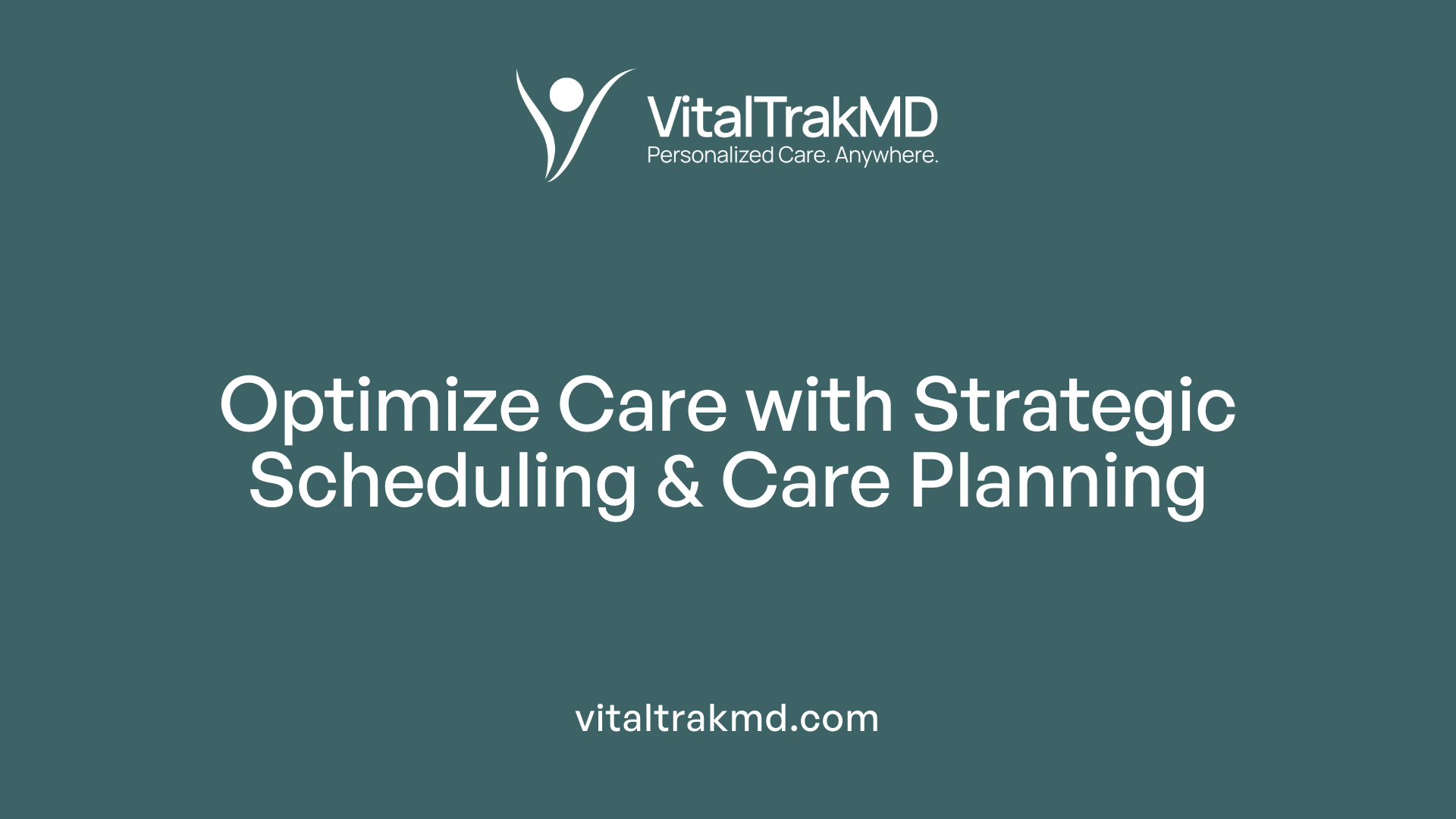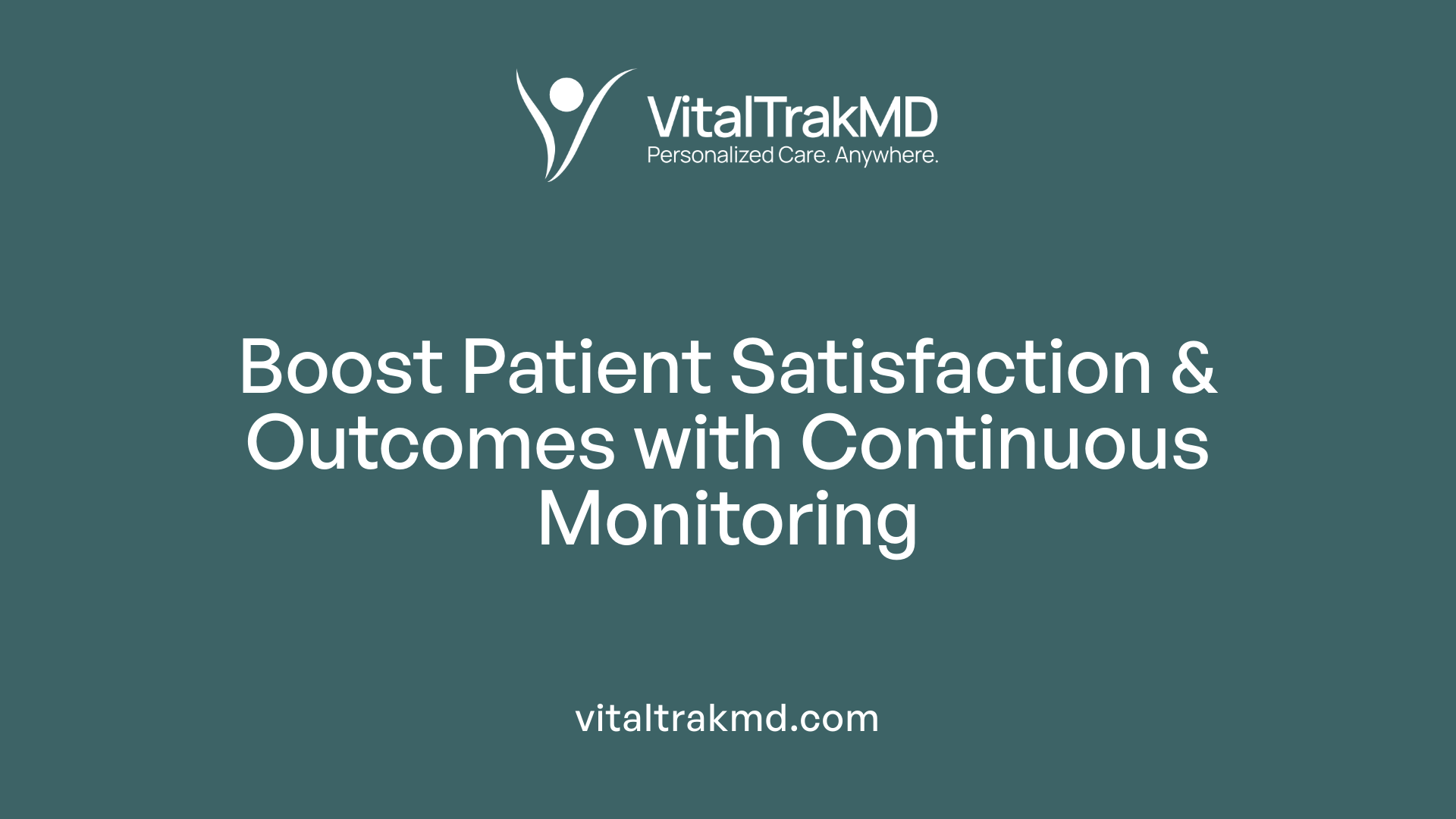Why Follow-Up Visits Are Key to Chronic Condition Stability

The Critical Role of Follow-Up Visits in Managing Chronic Diseases
Chronic diseases such as diabetes, hypertension, and heart failure require ongoing management to sustain health and prevent complications. Regular follow-up visits are the cornerstone of effective long-term disease control, enabling healthcare providers to closely monitor progress, update treatment plans, and support patient self-management. This article explores why follow-up care is essential for maintaining stability in chronic conditions, discusses optimal scheduling strategies, and examines how integrated care models leveraging technology can enhance outcomes.
The Significance of Follow-Up Visits in Chronic Disease Management
What is the significance of follow-up visits in managing chronic diseases?
Follow-up visits play a vital role in the ongoing management of chronic illnesses such as diabetes, hypertension, asthma, and heart disease. These visits provide an opportunity for healthcare providers to continuously monitor a patient's health status, ensuring that treatment plans remain effective and appropriately adjusted.
During these appointments, diagnostic tests can be conducted to evaluate treatment efficacy and detect any early signs of complications. This early detection is essential for timely interventions, which can prevent the progression of disease and reduce the risk of severe outcomes.
Moreover, follow-up visits reinforce patient education about medication adherence, lifestyle modifications, and disease management strategies. This ongoing engagement empowers patients to take an active role in their health, leading to better self-management and improved health behaviors.
Establishing regular follow-up routines also strengthens the relationship between patients and providers. Stronger bonds foster greater trust and satisfaction, which encourages patients to stay engaged with their care plans.
Additionally, coordinated follow-up care—including collaboration among primary care providers, specialists, nurses, and even telemedicine services—helps optimize resource use. Such comprehensive management can decrease hospital admissions, emergency visits, and overall healthcare expenses.
Overall, consistent and personalized follow-up visits are fundamental to achieving stable health in chronic disease patients, supporting long-term well-being, and reducing the burden on healthcare systems.
The Critical Role of Scheduling and Follow-Up Care Planning

Why are follow-up care and scheduling important in healthcare for patients with chronic conditions?
Follow-up visits are essential for managing chronic illnesses effectively. They ensure ongoing monitoring, allowing healthcare providers to track the progression of conditions like diabetes, hypertension, or asthma. Regular appointments also provide opportunities to review and adjust medications, address emerging symptoms, and clarify health issues, which helps patients stay engaged and informed.
Proper scheduling supports continuity of care, which has been shown to improve health outcomes and reduce hospital readmissions. For patients, adherence to follow-up plans fosters early detection of complications and adjustments—vital for maintaining disease stability. It also enables better care coordination among multiple providers, ensuring a unified treatment approach.
Beyond medical management, follow-up visits serve as touchpoints for preventive health discussions—covering lifestyle changes, vaccinations, and screenings—and emotional support, contributing to overall well-being. When follow-ups are well-planned and consistently scheduled, they empower patients, promote medication adherence, and foster a collaborative relationship with healthcare teams.
How do scheduling intervals vary based on condition severity and provider practices?
The timing of follow-up visits depends significantly on the patient's specific health condition. For stable chronic disease, routine follow-ups are often scheduled every six months, but more severe or unstable cases may require visits every few weeks or months.
Provider practices differ widely in how frequently they recommend revisits. Common intervals include 2, 3, or 6 months, but after adjusting for individual patient factors, the average interval ranges from 8 to 26 weeks. Provider practice style and local healthcare culture influence these timings, with some clinicians favoring more frequent reviews.
Variations in revisit intervals across providers
Research suggests that approximately 45% of the variance in revisit timing can be attributed to the individual provider's practice style.
Some physicians prefer shorter intervals to closely monitor high-risk patients, while others adopt longer intervals for stable patients. Even after accounting for patient-specific factors, roughly half of the variability remains unexplained, highlighting the significant influence of provider attitudes and local healthcare norms.
Impact of provider practice style and healthcare culture
Provider preferences and regional healthcare culture strongly affect scheduling practices. This variation can impact disease control, patient satisfaction, and healthcare efficiency. Addressing these differences involves standardizing guidelines while allowing flexibility for individual patient needs.
Strategic scheduling to optimize care delivery
To maximize the benefits of follow-up visits, healthcare systems can implement strategic scheduling. This involves utilizing electronic health records to identify high-risk patients, setting reminders, and tailoring revisit intervals based on disease control status.
Incorporating patient engagement tools, such as reminder calls or digital alerts, enhances adherence and ensures timely visits. Efficient scheduling also involves integrating routine assessments with preventive and wellness services, providing comprehensive care.
Importance of patient engagement and adherence to follow-up schedules
Patient participation in follow-up planning significantly impacts its success. Educating patients about the importance of scheduled visits, leveraging automated reminders, and involving them in care decisions encourage adherence.
Engaged patients are more likely to attend appointments, follow treatment plans, and report symptoms promptly. This proactive involvement helps maintain stability in chronic conditions, reduces emergency visits, and improves overall health outcomes.
For more details on scheduling strategies in chronic disease care, search for “Follow-up scheduling in chronic disease care.”
Long-Term Disease Control Facilitated by Follow-Up Appointments

How do follow-up appointments contribute to long-term disease control?
Follow-up visits are integral to managing chronic diseases over an extended period. They provide an opportunity for healthcare providers to monitor health outcomes and track the progression of the illness. Regular check-ins help identify any early signs of worsening symptoms or complications, allowing for prompt adjustments in treatment plans.
During these appointments, a personalized approach is adopted, focusing on specific goals tailored to each patient’s needs. This goal-oriented strategy encourages active patient participation and helps improve medication adherence, lifestyle changes, and overall disease management.
Moreover, follow-ups often involve a multidisciplinary team, including specialists, community health workers, and other care providers. This team-based model ensures that care addresses all aspects of a patient’s health, fostering coordinated interventions.
The use of advanced technology and data analytics further enhances management. Electronic health records (EHRs), remote patient monitoring, and predictive analytics enable providers to track health trends in real-time, foresee potential issues, and intervene proactively.
Through continuous, comprehensive management facilitated by regular follow-up, patients experience better stability of their condition, a reduced risk of hospitalizations, and an improved quality of life. Such proactive, personalized, and coordinated care mechanisms are essential to effective long-term disease control.
Post-Acute and Emergency Follow-Up: Ensuring Continuity and Recovery

What is the role of follow-up visits in post-acute and emergency care for chronic disease management?
Follow-up visits after hospitalizations or emergency department (ED) visits are vital for effective management of chronic conditions. These visits help monitor patient recovery, prevent readmissions, and address ongoing health needs. For individuals with complex, high-risk conditions like COPD, heart failure, or stroke, prompt follow-up within a week of discharge is especially recommended to ensure continuity of care. During these visits, healthcare providers review discharge instructions, adjust medications if necessary, and identify early signs of potential complications.
Multiple modes of follow-up are utilized, including in-person outpatient appointments, telehealth consultations, and virtual check-ins. This flexibility facilitates timely care, especially for patients with mobility issues or limited access to clinics. Regular follow-up not only reduces the risk of hospital readmission but also increases patient engagement and confidence in managing their health.
Overall, timely and effective post-acute follow-up is fundamental in helping patients transition safely from hospital to home, maintaining stability in their chronic illnesses, and achieving better health outcomes.
Enhancing Satisfaction and Outcomes Through Ongoing Monitoring

How does ongoing monitoring through follow-up visits improve patient satisfaction and health outcomes?
Follow-up visits are fundamental to building trust and strong relationships between patients and healthcare providers. When patients know that their health is continuously monitored and managed, they tend to feel more confident in their care, which boosts satisfaction.
Regular follow-ups allow for timely adjustments in treatment plans, helping to address issues before they escalate. This proactive approach leads to better disease control, fewer complications, and improved overall health outcomes.
Studies indicate that even with less frequent follow-up, patient satisfaction remains high. The reason is that personalized, tailored follow-up schedules—whether through in-person visits, phone calls, or telehealth—make patients feel cared for and involved in their health decision-making.
Technology-based communication methods, like telehealth and follow-up calls, significantly enhance interaction. They make it easier for patients to stay connected with their providers, ask questions, and report concerns, which strengthens the doctor-patient relationship.
Moreover, consistent follow-up reduces unnecessary healthcare visits and hospital readmissions by enabling early detection of health changes. This continuity of care minimizes adverse events, ultimately leading to better health outcomes.
Increased confidence and adherence to medication or lifestyle modifications are natural results of these ongoing relationships. When patients trust their providers and understand their health status, they are more likely to follow through with prescribed treatments.
The overall effect of these practices is a cycle of improved health, greater patient satisfaction, and more efficient use of healthcare resources. Continuity of care through regular follow-ups is proven to not only advance health outcomes but also foster a sense of security and satisfaction among patients.
The Influence of Organized Group Visits on Chronic Disease Management

Group care models and their benefits
Organized group visits are innovative approaches to managing chronic diseases. These models involve bringing together small groups of patients with similar conditions to receive medical evaluation, medication adjustments, and support in a shared setting. This format allows healthcare providers to maximize efficiency by engaging multiple patients simultaneously.
Such group settings promote peer support, reduce feelings of isolation, and encourage shared learning. Patients often gain motivation and confidence through interactions with others facing similar health challenges, which can lead to improved adherence to treatment plans.
Lower HbA1c levels and patient engagement
Research indicates that patients participating in group visits tend to have better health outcomes. For instance, individuals with diabetes who attend these sessions often see a reduction in their HbA1c levels—typically between 0.4% and 0.6%—compared to those receiving standard care.
The shared environment fosters open discussion, accountability, and motivation, which enhances patient engagement. When patients actively participate, they are more likely to follow lifestyle recommendations, adhere to medications, and attend regular follow-ups.
Planning and organizing group visits
Effective organization is crucial for successful group visits. Planning involves determining the appropriate group size—usually around a dozen patients—and developing a clear agenda that covers medical evaluations, educational topics, and lifestyle counseling.
Staff roles include organizing schedules, preparing educational materials, and coordinating with specialists when needed. It’s important to ensure the structure addresses specific patient needs and maintains a comfortable, interactive environment.
Confidentiality and HIPAA considerations
Maintaining patient confidentiality is paramount in group settings. Healthcare providers must adhere to HIPAA regulations by establishing guidelines that protect personal health information.
This includes obtaining informed consent from patients, clearly explaining confidentiality rights, and designing sessions to minimize disclosures of sensitive information. Confidentiality agreements and trained staff help create a safe space where patients feel comfortable sharing.
Enhanced education and peer support
One of the major advantages of group visits is the opportunity for peer support and education. Patients learn from each other's experiences, ask questions, and discuss strategies for managing their conditions.
Facilitators can incorporate interactive discussions on medication management, lifestyle changes, and coping mechanisms. This collaborative environment often leads to increased motivation, better self-management skills, and ultimately, improved health outcomes.
| Aspect | Description | Additional Details |
|---|---|---|
| Model Benefits | Improved health outcomes and patient satisfaction | Includes peer support and education |
| Outcomes | HbA1c reduction, increased adherence | Evidence-based benefits |
| Planning | Group size, agenda development | Focus on patient needs |
| Confidentiality | HIPAA compliance, informed consent | Ensuring privacy |
| Education | Peer learning, facilitator-led | Encourages active participation |
Organized group visits are an effective strategy to enhance chronic disease management. They foster a supportive environment where patients can learn, share, and stay motivated, ultimately leading to better health control and quality of life.
Billing and Reimbursement Strategies for Follow-Up and Preventive Visits
When and how should healthcare providers bill for follow-up and preventive visits?
Proper billing for follow-up and preventive visits is essential to ensure healthcare providers are adequately reimbursed while maintaining compliance with billing regulations. When a healthcare provider addresses a medical problem during a preventive or wellness visit, and additional significant work is performed—such as managing a chronic condition, evaluating symptoms, or adjusting treatment—they can bill for both services.
Recent changes in Evaluation and Management (E/M) coding, introduced in 2021, have simplified this process. Instead of requiring full physical exams or detailed histories to determine billing levels, providers now have the option to base billing on total time spent or medical decision making (MDM). Documentation should clearly reflect the significant work performed, including problem review, exam findings, and management plans.
In cases where diagnosis or treatment of a new or existing problem occurs during a preventive visit, providers should use modifier 25 to indicate the provision of a separately identifiable service. This applies to problem-oriented E/M codes (99202-99215). Medicare has designated specific codes for wellness visits, such as G0402, G0438, and G0439, which typically do not include management of problems. However, providers can bill separately for problem management when appropriate, provided they meet documentation requirements.
It is vital for scheduling staff to verify the patient’s Medicare eligibility and inform them about potential additional costs if problem management services are conducted during a preventive visit, as Medicare does not pay for certain preventive CPT codes in original Medicare plans.
Proper documentation supporting the medical necessity and distinctiveness of services is crucial. This ensures accurate billing, compliance with regulations, and appropriate reimbursement for the time and effort invested in comprehensive patient care.
Use of E/M codes and modifiers
To maximize reimbursement, providers should familiarize themselves with the appropriate E/M codes corresponding to the visit type and complexity. When delivering both preventive and problem-focused care in a single encounter, the use of modifier 25 signals that the service was significantly separate from the preventive component.
Additionally, recent coding guidelines prioritize MDM and total time over traditional history and exam components. Accurate, detailed documentation of the work involved, including discussions, decision-making, and patient education, is essential to support billing at higher levels.
Strategies to optimize healthcare resources and reimbursement
Optimizing billing involves not only correct code selection but also integrating strategic practices such as:
- Verifying patient insurance and coverage options beforehand.
- Clearly documenting all services, discussions, and decision processes.
- Using the latest coding guidelines to select appropriate codes based on MDM or total time.
- Educating patients about potential costs related to additional services.
Implementing efficient documentation practices and utilizing billing software that aligns with current regulations can streamline workflows and reduce errors.
Overall, understanding and applying these billing strategies ensure providers can deliver comprehensive care while securing appropriate reimbursement, ultimately supporting sustained, quality chronic disease management.
The Future of Chronic Care Management: Leveraging Technology and Data Analytics
Personalized Care Plans via Electronic Health Records (EHRs)
Advanced EHR systems enable healthcare providers to create tailored, comprehensive care plans for each patient with chronic conditions. These systems integrate medical histories, test results, medication lists, and patient preferences, facilitating more precise and individualized management strategies. By updating and accessing these plans in real-time, providers can quickly adjust treatments and coordinate care more effectively.
Remote Patient Monitoring (RPM)
RPM technology allows continuous tracking of vital signs and other health indicators outside the clinical setting. Devices such as wearable sensors and home monitoring tools transmit data directly to healthcare teams, enabling early detection of health deterioration. This proactive approach reduces hospital readmissions and enhances patient engagement, especially for conditions like heart failure, diabetes, and COPD.
Data Analytics and Predictive Modeling
Leveraging big data analytics and machine learning algorithms, healthcare providers can identify patterns and predict potential health crises. These insights help in stratifying patient risk levels, prioritizing interventions, and customizing follow-up schedules. Predictive models support early action, thus improving outcomes and optimizing resource utilization.
Integrated Care Models and Social Determinants of Health
Integrated care approaches connect primary care, specialists, social services, and community resources. Addressing social determinants—such as housing, nutrition, and transportation—plays a critical role in managing chronic diseases. Future models aim for holistic care that considers all aspects of a patient's environment, leading to better health outcomes and reduced disparities.
Transitional Care Management
Effective transition planning between hospitalization and outpatient care remains vital. Technology facilitates seamless sharing of discharge summaries, medication lists, and follow-up instructions. Programs focusing on transitional care employ remote check-ins and patient education to ensure continuity, minimize gaps, and prevent readmissions.
| Technology/Approach | Benefits | Future Potential |
|---|---|---|
| Personalized EHRs | Custom treatment plans | Real-time updates and AI integration |
| RPM | Continuous health data collection | Early detection, targeted interventions |
| Data Analytics | Risk stratification and predictions | Improved proactive care |
| Care Integration | Holistic patient management | Addressing social determinants |
| Transition Support | Seamless hospital to home | Reduced readmission rates |
As health systems increasingly adopt these innovations, chronic disease follow-up care is poised to become more precise, proactive, and personalized, ultimately improving patient outcomes and reducing healthcare costs.
The Impact of Care Continuity and Provider Practice Style on Outpatient Service Use
How does care continuity influence outpatient visits?
Continuity of care plays a vital role in managing chronic illnesses effectively. When patients maintain consistent contact with their healthcare providers, they experience fewer unnecessary outpatient visits, leading to better health outcomes and higher satisfaction. Studies have shown that higher care continuity, measured by the consistency of care providers, is associated with fewer emergency visits and hospitalizations. This process fosters trust and familiarity, allowing physicians to identify and address health issues early, preventing complications that often lead to more frequent appointments.
The role of follow-up visits cannot be overstated—they ensure ongoing monitoring, medication adjustment, and early detection of health changes. For patients with complex or unstable conditions, regular follow-ups help maintain the stability of their health status, thus reducing the need for urgent or unnecessary outpatient care.
Why does provider practice style cause variability in follow-up intervals?
Research indicates that the timing of follow-up visits varies significantly depending on the individual healthcare provider's practice style and local healthcare culture. Even after adjusting for patient-specific factors such as age, health status, and insurance coverage, about 45% of the variation in revisit intervals can be attributed to the provider’s approach.
Some providers prefer more frequent follow-ups, like every 2 or 3 months, particularly for patients with chronic illnesses like diabetes or hypertension, to closely monitor and manage their condition. Others may schedule follow-ups every 6 months or longer, especially when the condition is stable. This variability highlights how personal practice style and practice norms influence the timing and frequency of follow-up care.
How does Andersen's behavioral model explain healthcare-seeking behavior?
The Andersen model provides a framework to understand why patients seek healthcare and how their behavior affects outpatient service use. It considers predisposing factors (such as age and health beliefs), enabling factors (like insurance and accessibility), and need factors (perceived or evaluated health status).
Applying this model, researchers found that factors like insurance type—particularly URRBMI coverage—encourage more routine visits, whereas perceived convenience of reimbursement positively influences outpatient service utilization.
Despite these insights, about half the variation in follow-up intervals remains unexplained, underscoring the strong influence of provider preferences and practice norms. This model emphasizes the importance of aligning patient, provider, and systemic factors to optimize continuous care.
What strategies can improve care continuity?
Enhancing continuity requires a combination of approaches. Developing stronger primary care systems and promoting organized, patient-centered practices can encourage more consistent follow-ups.
Implementing proactive scheduling, automated reminders, and patient education improves appointment adherence. Additionally, integrated use of Electronic Health Records (EHRs) helps providers access comprehensive patient data, facilitating personalized care and timely follow-ups.
Technology innovations such as Remote Patient Monitoring (RPM) allow real-time health data tracking, making outpatient follow-up more flexible and responsive. Moreover, value-based care models and chronic care management programs incentivize providers to prioritize ongoing patient engagement.
Effective communication among care teams, patient advocacy, and addressing social determinants of health further contribute to sustaining care continuity and reducing unnecessary outpatient visits.
| Aspect | Strategies | Expected Outcomes |
|---|---|---|
| Care system organization | Strengthen primary care, plan follow-up scheduling | Increased adherence, fewer emergency visits |
| Patient engagement | Education, reminders, self-management support | Better health outcomes, reduced hospital readmissions |
| Use of technology | EHRs, RPM, telehealth | Timelier interventions, higher follow-up rates |
| Provider practices | Standardize follow-up protocols, professional training | Consistent care delivery, reduced practice variability |
Focusing on these strategies can help bridge the gap between recommended practices and real-world care delivery, ultimately improving the management of chronic diseases.
Promoting Long-Term Stability through Consistent Follow-Up
In conclusion, follow-up visits are a vital component of managing chronic diseases effectively. They enable continuous monitoring, timely adjustments, and sustained patient engagement, ultimately leading to better health outcomes, reduced hospitalizations, and improved quality of life. Healthcare systems should prioritize well-planned follow-up schedules, leverage innovative care models like chronic care management and telehealth, and foster strong patient-provider relationships to promote long-term stability for individuals living with chronic conditions. A proactive, coordinated approach to follow-up care is essential in achieving enduring health and well-being.
References
- Chronic Disease? Follow-up Visits are a Must! - Urgent Care
- Is There Time for Management of Patients With Chronic Diseases in ...
- The Role of Patients and Providers in the Timing of Follow-up Visits
- Follow Up Visits Boost Your Health While Saving You Time And ...
- 3 Important Reasons to Follow Up with Your Primary Care Provider ...
- [PDF] CLINICAL GUIDELINE:
- How Patient Advocates Help Navigate Treatment Changes ... - Solace
- How group visits can improve chronic condition management
- Combining a Wellness Visit With a Problem-Oriented Visit: a Coding ...
Recent articles
Want to Feel Better and Live Healthier?
Join hundreds of patients taking control of their health with personalized care that fits their life – not the other way around.
Rated 4.8/5 by 32+ customers







